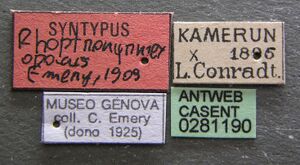Tetramorium opacum
| Tetramorium opacum | |
|---|---|

| |
| Scientific classification | |
| Kingdom: | Animalia |
| Phylum: | Arthropoda |
| Class: | Insecta |
| Order: | Hymenoptera |
| Family: | Formicidae |
| Subfamily: | Myrmicinae |
| Tribe: | Crematogastrini |
| Genus: | Tetramorium |
| Species: | T. opacum |
| Binomial name | |
| Tetramorium opacum (Emery, 1909) | |
| Synonyms | |
| |
Identification
Keys including this Species
Distribution
Latitudinal Distribution Pattern
Latitudinal Range: -0.317° to -5.5°.
| North Temperate |
North Subtropical |
Tropical | South Subtropical |
South Temperate |
- Source: AntMaps
Distribution based on Regional Taxon Lists
Afrotropical Region: Cameroun (type locality), Guinea, Kenya.
Distribution based on AntMaps
Distribution based on AntWeb specimens
Check data from AntWeb
Countries Occupied
| Number of countries occupied by this species based on AntWiki Regional Taxon Lists. In general, fewer countries occupied indicates a narrower range, while more countries indicates a more widespread species. |

|
Estimated Abundance
| Relative abundance based on number of AntMaps records per species (this species within the purple bar). Fewer records (to the left) indicates a less abundant/encountered species while more records (to the right) indicates more abundant/encountered species. |

|
Biology
Castes
Images from AntWeb
   
| |
| Syntype of Tetramorium opacum. Worker. Specimen code casent0281190. Photographer Estella Ortega, uploaded by California Academy of Sciences. | Owned by MSNG, Genoa, Italy. |
  
| |
| Syntype of Rhoptromyrmex opacus esta. Worker. Specimen code casent0901030. Photographer Ryan Perry, uploaded by California Academy of Sciences. | Owned by NHMUK, London, UK. |
   
| |
| Holotype of Rhoptromyrmex opacus monodi. Worker. Specimen code casent0914275. Photographer Michele Esposito, uploaded by California Academy of Sciences. | Owned by MNHN, Paris, France. |
Nomenclature
The following information is derived from Barry Bolton's Online Catalogue of the Ants of the World.
- opacum. Rhoptromyrmex opacus Emery, in Forel, 1909b: 59 (footnote) (w.) CAMEROUN. Combination in Tetramorium: Ward et al., 2014: 15. Bolton, 1986a: 15 (q.m.). Senior synonym of esta, laeviceps, monodi: Brown, 1964c: 15.
- esta. Rhoptromyrmex opacus var. esta Forel, 1909b: 59 (w.q.m.) DEMOCRATIC REPUBLIC OF CONGO. Junior synonym of opacus: Brown, 1964c: 15.
- laeviceps. Rhoptromyrmex opacus var. laeviceps Santschi, 1916b: 504 (w.) DEMOCRATIC REPUBLIC OF CONGO. Junior synonym of opacus: Brown, 1964c: 15.
- monodi. Rhoptromyrmex opacus r. monodi Bernard, 1953b: 251, fig. 14 (w.) GUINEA. Junior synonym of opacus: Brown, 1964c: 15.
Unless otherwise noted the text for the remainder of this section is reported from the publication that includes the original description.
Description
Worker with predominantly fine, opaque reticulate-punctulate sculpture over head and mesonotum; in some smaller specimens, the cephalic sculpture may be more shallow and more nearly shining. Metanotal groove present, moderately to deeply impressed. Petiolar node moderate in height, with broadly rounded summit; postpetiole subglobular, slightly wider than petiolar node and wider than long, its ventral surface without a prominent rounded process or tumulus. Color dull yellow to brownish-orange; according to Bernard, the type of subsp. monodi has the occiput and mesonotum blackish-brown. (after Brown, 1964i).
Type Material
Bolton (1976) - Syntype workers, Cameroun. (Conradt), Museo Civico di Storia Naturale, Genoa.
References
- Bolton, B. 1976. The ant tribe Tetramoriini (Hymenoptera: Formicidae). Constituent genera, review of smaller genera and revision of Triglyphothrix Forel. Bulletin of the British Museum (Natural History). Entomology. 34:281-379.
- Bolton, B. 1986a. A taxonomic and biological review of the tetramoriine ant genus Rhoptromyrmex (Hymenoptera: Formicidae). Syst. Entomol. 11: 1-17 (page 15, queen, male described)
- Brown, W. L., Jr. 1964e. Genus Rhoptromyrmex, revision of, and key to species. Pilot Regist. Zool. Card No. 11.
- Brown, W. L., Jr. 1964i. Rhoptromyrmex opacus, new synonymy of, and brief characterization. Pilot Regist. Zool. Card No. 15. (page 15, Senior synonym of esta, laeviceps and monodi)
- Forel, A. 1909b. Fourmis du Musée de Bruxelles. Fourmis de Benguela récoltées par M. Creighton Wellman, et fourmis du Congo récoltées par MM. Luja, Kohl et Laurent. Ann. Soc. Entomol. Belg. 53: 51-73 (page 59, (footnote) worker described)
- Ward, P.S., Brady, S.G., Fisher, B.L., Schultz, T.R. 2015. The evolution of myrmicine ants: phylogeny and biogeography of a hyperdiverse ant clade (Hymenoptera: Formicidae). Systematic Entomology 40: 61–81 (doi:10.1111/syen.12090).
References based on Global Ant Biodiversity Informatics
- Bernard F. 1953. La réserve naturelle intégrale du Mt Nimba. XI. Hyménoptères Formicidae. Mémoires de l'Institut Français d'Afrique Noire 19: 165-270.
- Bolton B. 1976. The ant tribe Tetramoriini (Hymenoptera: Formicidae). Constituent genera, review of smaller genera and revision of Triglyphothrix Forel. Bulletin of the British Museum (Natural History). Entomology 34:281-379.
- Bolton B. 1986. A taxonomic and biological review of the tetramoriine ant genus Rhoptromyrmex (Hymenoptera: Formicidae). Systematic Entomology 11: 1-17.
- Brown W. L., Jr. 1964. Rhoptromyrmex opacus, new synonymy of, and brief characterization. Pilot Regist. Zool. Card No. 15.
- Dejean A., F. Azemar, R. Cereghino, M. Leponce, B. Corbara, J. Orivel, and A. Compin. 2015. The dynamics of ant mosaics in tropical rainforests characterized using the SelfOrganizing Map algorithm. Insect Science doi: 10.1111/1744-7917.12208
- Medler J. T. 1980: Insects of Nigeria - Check list and bibliography. Mem. Amer. Ent. Inst. 30: i-vii, 1-919.
- Wheeler W. M. 1922. Ants of the American Museum Congo expedition. A contribution to the myrmecology of Africa. II. The ants collected by the American Museum Congo Expedition. Bulletin of the American Museum of Natural History 45: 39-269.
- Wheeler W. M. 1922. Ants of the American Museum Congo expedition. A contribution to the myrmecology of Africa. VIII. A synonymic list of the ants of the Ethiopian region. Bulletin of the American Museum of Natural History 45: 711-1004

